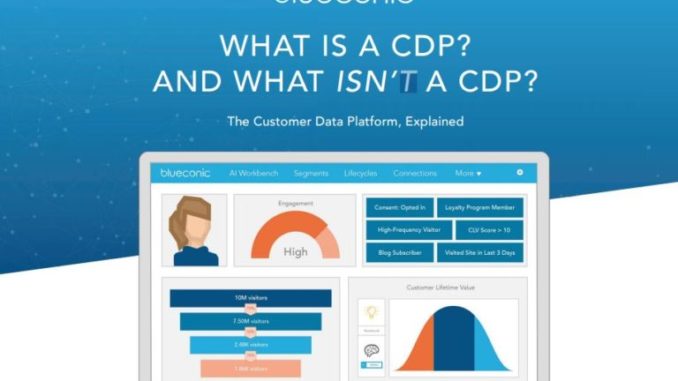
30-second summary:
BlueConic is a CDP provider that works with hundreds of clients including Hearst, Moen, T-mobile, and ING.
Their newly published eBook is aimed at helping marketers understand the role of the CDP in the larger martech stack — what it is, what it’s not, and how it compares with other tools.
BlueConic’s free eBook — What is A CDP? And What Isn’t a CDP? — is available from ClickZ.
Headquartered in Boston, Massachusetts, BlueConic is a Customer Data Platform (CDP) provider that works with hundreds of organizations globally.
Their technology combines first-party data into one unified location, making it easily accessible to all marketers and other employees, regardless of department or location. Some of BlueConic’s clients include top brands like Hearst, Moen, T-mobile, and ING.
BlueConic recently published an eBook aimed at helping organizations understand the role of CDPs within the martech landscape including what they are (and aren’t), how they compare with other martech like CRMs, and what marketers should look for when searching for a CDP solution.
This post summarizes some of the key points in BlueConic’s guide. You can download the free eBook — What is A CDP? And What Isn’t a CDP? — from here.
Content created in partnership with BlueConic.
What is a customer data platform?
Simply put, a CDP is a platform that unifies an organization’s first-party and third-party marketing and other data into one location and makes it accessible to other systems.
This enables marketers and other stakeholders to view campaign and customer data in a single interface, providing a single, persistent customer view or “source of truth” from which to glean insights, understand trends, and make data-driven decisions about campaign optimization and planning.
BlueConic writes, “Other systems — particularly marketing cloud suites — claim to provide the ‘360 degree’ view of every person in one’s martech ecosystem. But only the CDP offers a complete picture of prospects and customers — and in a single UI.”
Per BlueConic, a pure-play CDP offers four core capabilities, as follows:
Unified, persistent customer profiles — Data points from each customer are stored in one location, creating a consistent customer profile that’s updated dynamically.
Multi-dimensional segmentation — Users can compare a variety of customer attributes to create segments across channels, enabling predictive and behavioral segmentation.
Customer lifecycle orchestration — Users gain control of the entire customer lifecycle through data-driven analysis and activation.
Predictive modeling and analytics — CDPs enable modeling to aid with building customer segments, data visualization, customer/lead scoring, and more.
The CDP’s database structure is what powers its capabilities. Based on this, BlueConic defines three types of CDP databases: a relational database CDP, an event-stream database CDP, and a profile database CDP, with more granular information about each type of structure included in the eBook.
The CDP’s value to marketers
The CDP’s value lies in its ability to unify marketing data across an organization’s legacy tech stack, merging data from campaign management tools, ESPs, ad technology, and more.
BlueConic writes, “Many marketers don’t have a ‘single customer view’ deliberately designed for marketing purposes. This puts them at the mercy of IT, data scientists, and agencies to dictate when, where, and how they can use their data.”
CDPs are explicitly designed with marketers in mind, providing seamless access to all relevant marketing data whenever marketers need it (no IT skills necessary).
Source: BlueConic
Where the CDP fits into your martech stack
The need for CDPs arose because disparate tools such as marketing cloud suites were ‘franken stacks’ containing martech tools that were difficult to integrate.
These disparate tools hindered marketing teams and limited business growth because they failed to unify an organization’s data and make it actionable. They also didn’t easily connect first-party and third-party data.
First-party data unification and activation are critical to comply with growing privacy regulations. The shift from third to first party data utilization has had positive results, per statistics cited in the eBook:
In 2019, 36% of executives said increasing first-party data quantity and quality was crucial for their brands.
In 2019, 78% of marketing professionals increased the use of first-party data.
A 2017 Forbes report found that 41% of “high-performance marketers” used first-party data in their overarching marketing strategies.
First-party data must be integrated into a “single-source” of truth before it can be used to assist marketers with customer analysis, personalization, and targeting.
BlueConic writes, “In short, to develop successful and scalable strategies today, marketing organizations need a system of record in which all first-party customer data can be unified and then activated with great ease.”
What a CDP isn’t
BlueConic provides a comprehensive comparison of what does and does not constitute a CDP versus other tools like data management platforms (DMPs), CRMs, and campaign management software.
For example, while CDPs give marketers complete control over data access and integrations with other tools, CRMs provide minimal access to data and no control over integrations.
Likewise, from a data integrity perspective, marketing clouds typically provide segment-level only, person-level customer service records siloed in each application versus CDPs that offer person-level profiles based on all customer attributes and behaviors.
The eBook contains much more in-depth information on what to look for in a CDP, some customer success stories, and more details about where the CDP fits into the overall martech stack.
Per BlueConic, “Simply put, marketers should look for a customer data platform that enables them to quickly and efficiently adjust their messaging and programs.”
To get a more in depth perspective, you can download BlueConic’s free eBook — What is A CDP? And What Isn’t a CDP? — from here.
The post This is what a customer data platform (CDP) is designed to do appeared first on ClickZ.
Source: ClickZ
Link: This is what a customer data platform (CDP) is designed to do


